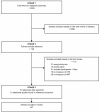The relationship between active travel to school and health-related fitness in children and adolescents: a systematic review
- PMID: 21269514
- PMCID: PMC3039551
- DOI: 10.1186/1479-5868-8-5
The relationship between active travel to school and health-related fitness in children and adolescents: a systematic review
Abstract
Background: Active travel to school (ATS) has been identified as an important source of physical activity for youth. However, the relationship between ATS and health-related fitness (HRF) among youth remains unclear.
Methods: A systematic search of seven electronic databases (EMBASE, OVID MEDLINE, PsycINFO, PubMed, Scopus, SPORTDiscus and TRIS on line) was conducted in December 2009 and studies published since 1980 were considered for inclusion.
Results: Twenty seven articles were identified that explored the relationship between ATS and the following aspects of HRF: weight status/body composition, cardiorespiratory fitness, muscular fitness and flexibility. Forty-eight percent of the studies that examined the relationship between ATS and weight status/body composition reported significant associations, this increased to 55% once poor quality studies were removed. Furthermore, the findings from five studies, including one longitudinal study, indicate that ATS is positively associated with cardiorespiratory fitness in youth. However, the evidence for the relationships between ATS and muscular fitness or flexibility is equivocal and limited by low study numbers.
Conclusions: There is some evidence to suggest that ATS is associated with a healthier body composition and level of cardiorespiratory fitness among youth. Strategies to increase ATS are warranted and should be included in whole-of-school approaches to the promotion of physical activity.
© 2011 Lubans et al; licensee BioMed Central Ltd.
Figures
References
Publication types
MeSH terms
LinkOut - more resources
Full Text Sources
Medical


